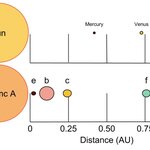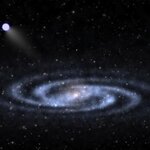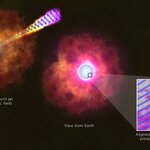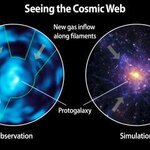Space

Images of Saturn's auroras as the planet's magnetic field is battered by charged particles from the Sun have led a team to claim decisive evidence for the hypothesis that Saturn's auroral displays are often caused by the dramatic collapse of its "magnetic tail".
Just like comets, planets such as Saturn and the Earth have a "tail" – known as the magnetotail – that is made up of electrified gas from the Sun and flows out in the planet's wake.
When a particularly strong burst of particles from the Sun hits Saturn, it can cause the magnetotail to collapse, with the ensuing disturbance of the…

Elon Musk's ideas are in the news right now, rockets with first stages that fly back to a soft landing under auto pilot. But you might be surprised to learn how many other ideas there are under active development, for low cost ways to get into orbit.
The British Skylon would fly directly into space from a reinforced airport, taking off like a plane, without need to discard anything (single stage to orbit). Then JP Aerospace plan airships to float up to 200,000 feet followed by transfer to a lighter than gossamer skinned, "orbital airship" that never lands, but can accelerate gradually through…

Last year, people began wondering why part of the sun was missing. What had happened was that changes to the magnetic field were allowing hot plasma to fly off into space toward Earth, creating a coronal hole.
Coronal holes are actually happening less right now, because we are experiencing a solar maximum. During this portion of the recurring cycle, the number of coronal holes decreases. During solar max, the magnetic fields on the sun reverse and new coronal holes appear near the poles with the opposite magnetic alignment.
The coronal holes then increase in size and number, extending…

The astronomer Giovanni Schiaparelli first described them as 'canali' in the 19th century. A conspicuous net-like system of deep gorges known as the Noctis Labyrinthus is clearly visible on Mars' equatorial region.
The gorge system, in turn, leads into another massive canyon, the Valles Marineris, which is 4,000 km long, 200 km wide and 7 km deep. Both of these together would span the US completely from east to west.
These gorges resemble terrestrial canyons formed by water so most researchers assumed that immense flows of water must have carved the Noctis Labyrinthus and the Valles…

One of the most fascinating nearby planetary systems, 55 Cancri, is now less mysterious.
Hopefully. The authors say theirs is the first viable model for the planetary system
of 55 Cancri, one the first stars discovered to have planets.
Numerous studies since 2002 had failed to determine a plausible model for the masses and orbits of two giant planets located closer to 55 Cancri than Mercury is to our Sun. Astronomers had struggled to understand how these massive planets orbiting so close to their star could avoid a catastrophe such as one planet being flung into the star, or…

A newly discovered "hypervelocity star" is the closest, second-brightest and among the largest found so far. It is speeding at more than 1 million mph and may provide clues about the supermassive black hole at the center of our Milky Way. Also, add in the obligatory "dark matter" reference.
Hypervelocity stars appear to be remaining pairs of binary stars that once orbited each other and got too close to the supermassive black hole at the galaxy's center. Intense gravity from the black hole – which has the mass of 4 million stars like our sun – captures one star so it orbits the hole closely…

Astronomers have made a measurement of a distant neutron star that is one million times more precise than the previous world's best - and they did it by using...nothing.
The interstellar medium is the 'empty' space between stars and galaxies. It's not really empty, it is made up of sparsely spread charged particles and those can be used as a giant lens. The astronomers did just that, to magnify and look closely at the radio wave emission from a small rotating neutron star.
Result: the highest resolution measurement ever achieved, equivalent to being able to see the double-helix structure of…

One of the most powerful events in our universe – Gamma-Ray Bursts (GRB) – behave differently than previously thought, and this evidence from observation of a GRB rules out most of the existing hypothetical predictions concerning the afterglow of the explosions.
"About once per day, a short, very bright flash of gamma-rays (the most energetic form of light) is detected by satellites. These flashes are called gamma-ray bursts (GRBs), and take place in galaxies far away, when a massive star collapses at the end of its life," says Dr. Klaas Wiersema, of the University of Leicester's Department…

Astronomers have taken unprecedented images of the intergalactic medium (IGM) — the diffuse gas that connects galaxies throughout the universe — with the Cosmic Web Imager, which was designed and built at the California Institute of Technology.
Until now, the structure of the IGM has mostly been a matterof speculation, but with observations from the Cosmic Web Imager, deployed on the Hale 200-inch telescope at Palomar Observatory, astronomers are obtaining our first three-dimensional pictures of the IGM.
The Cosmic Web Imager will make possible a new understanding of galactic and…

A team of researchers led by Robert Quimby at the Kavli Institute for the Physics and Mathematics of the Universe (Kavli IPMU) has announced the discovery of a galaxy that magnified a background, Type Ia supernova thirtyfold through gravitational lensing. This is the first example of strong gravitational lensing of a supernova confirms the team's previous explanation for the unusual properties of this supernova.
The team has further shown how such discoveries of supernovae of Type Ia (SNIa) can be made far more common than previously thought possible. SNIa seen through gravitational…